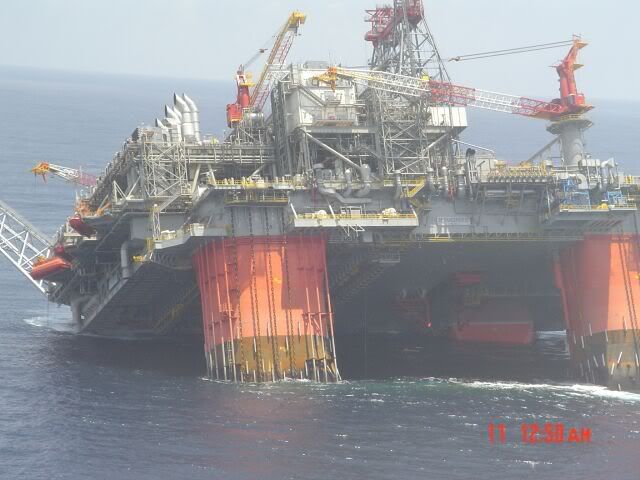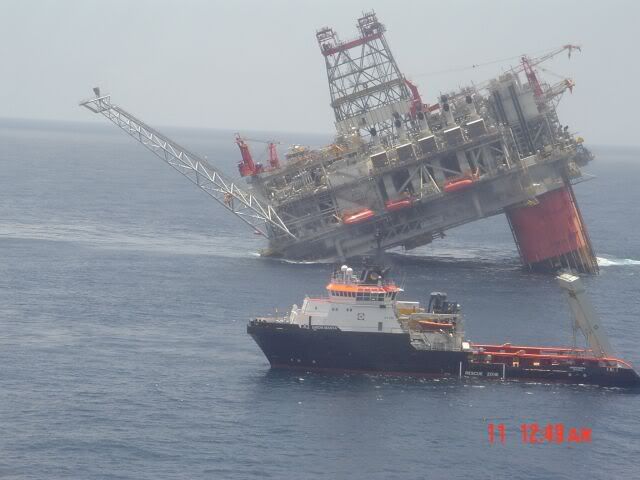MolaKule
Staff member
quote:
BP's Gigantic Oil Platform Lists After Hurricane in Gulf
Plight of $1 Billion Project Shows Risk Industry Takes To Gain Technological Edge
The Wall Street Journal 07/13/05
author: Russell Gold
author: Bhushan Bahree
(Copyright (c) 2005, Dow Jones & Company, Inc.)
The world's largest offshore-oil platform, 75% owned by BP PLC, is listing precariously after Hurricane Dennis swept through the Gulf of Mexico this past weekend, in a mishap that underscores the big risks the energy industry runs as it takes on increasingly costly and ambitious projects.
Workers returned yesterday to the 170,000-square-foot platform, called Thunder Horse and only slightly smaller in area than a typical Wal-Mart supercenter, to begin assessing the damage to the $1 billion structure. BP, which self-insured the project, had expected oil and natural-gas production to begin later this year. Exxon Mobil Corp., which owns the other 25%, also said it was self-insured and referred questions to BP.
Hurricane Dennis packed sustained winds of 145 miles an hour as it passed to the east of Thunder Horse. So far, the company is unsure what caused the platform to list. Last Thursday, a huge winch weighing several tons dropped into the water as it was being stowed away prior to the storm. However, there is "no evidence so far that it played any part in the subsequent events," said a BP spokesman. All personnel were evacuated on Friday, prior to the storm.
Although Thunder Horse wasn't yet producing, news of its plight sent a shudder through oil futures markets, where prices rose yesterday as the oil industry braced for a new storm, Tropical Storm Emily. On the New York Mercantile Exchange, U.S. benchmark crude oil for August delivery traded at $60.62 a barrel, up $1.70.
Thunder Horse was the oil industry's crown jewel in the Gulf of Mexico: a technological marvel designed to float in 6,000 feet of water and suck large volumes of oil and gas from dozens of nearby wells. BP had expected the facility to produce 250,000 barrels of oil a day and 200 million cubic feet of gas by 2007, when as many as 25 wells would be connected. That is about 9% of current oil and gas production in the Gulf, an energy-rich region that provides about a quarter of total U.S. production.
Western oil companies in recent years have been turning to mega-offshore projects such as Thunder Horse to boost global production and maintain a competitive edge over increasingly ambitious national oil companies. The so-called supermajors claim that only mature, sophisticated companies are capable of pulling off projects of this scope. Thunder Horse's shaky situation highlights the downside of relying on complex, cutting-edge technologies.
"All of us in the industry are looking at what happened to Thunder Horse and hoping it can be solved quickly. It's a black eye for all of us," says Alan Verret, executive director of the Offshore Operators Committee, a New Orleans trade association of oil and gas operators in the Gulf of Mexico.
Thunder Horse was towed in April to its current location, about 150 miles southeast of New Orleans. It floats in the Gulf, tethered to the ocean floor by 16 anchors.
The scope and cost of repairs -- if Thunder Horse can be saved -- is yet to be determined. A BP spokesman said a remotely operated vehicle had found no evidence of damage to the platform's hull. He also said the company was able to get a crew aboard to restore power and was preparing to take actions to right the platform.
In 2001, an explosion damaged what was then the world's largest floating, semisubmersible platform. The facility, owned by Brazilian oil company Petróleo Brasileiro SA, listed at an angle only slightly more severe than Thunder Horse and sank within a week.
The global oil industry has skimped for years on investment in oil-and-gas producing and refining infrastructure, in part because the publicly traded companies were concerned about taking on too much risk. The vulnerability of offshore Gulf platforms and oil-and-gas transmission lines was exposed last year by Hurricane Ivan, which caused extensive damage that sharply reduced output and took many months to repair.
Analysts expect repairs to slow BP's efforts to increase its global production. The project was expected to add 4.5% to BP's oil-and-gas production next year, according to New York investment bank Goldman Sachs Group Inc. "The worst-case scenario would be that the facility sinks," said Goldman Sachs. Such a loss could lower BP's long-term output growth from 3% to 2% a year.
In 4 p.m. New Stock Exchange composite trading, BP American depositary shares were down 73 cents to $65.70, while Exxon shares were down eight cents to $59.89.
BP is nearing completion of a similar, though smaller and less complex platform, named Atlantis. It is currently being pieced together near Corpus Christi, Texas, and is expected to begin production about 100 miles southwest of Thunder Horse in the third quarter of 2006.
This is the latest in a string of setbacks and accidents for BP, a London energy titan. In March, an explosion ripped through its refinery in Texas City, killing 15 workers. In January, BP paid $716,000 in fines to an Alaska state agency stemming from a 2002 well explosion that severely injured a worker.



